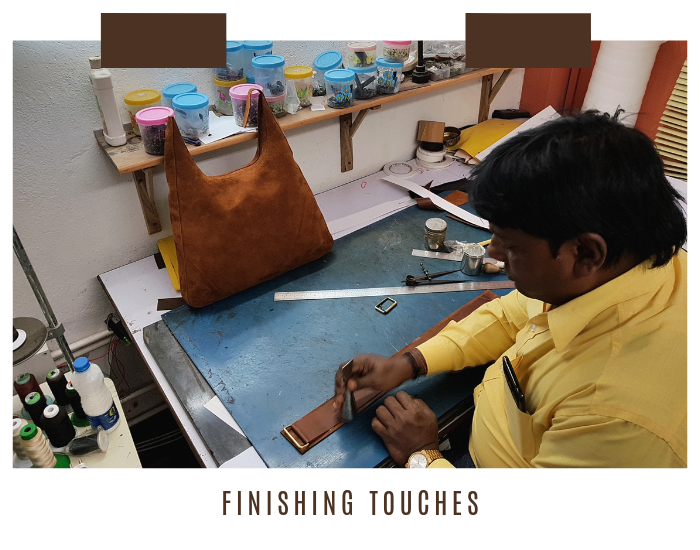At Scaramanga we’re proud of how our beautiful classic leather satchels are designed, and the hardworking, highly skilled men and women who create our bags. We believe in making classic leather satchels and bags using traditional tools and materials and most importantly of all, staying true to original leather working techniques and traditions. Our leather bags are still made the same way they would have been made in Britain 60 years ago.
Our Indian leather satchel, messenger and travel bag makers have been working in the leather industry for over 75 years. During the second world war they made cases, bags, belts and for the British and Indian Armies – an incredibly important role. The business has been managed by three generations of the same family, who are considered pioneers of antique and vegetable tanned (VT) leathers in eastern India. We only work with small scale and family run enterprises see our ethical policy.
We are going to take you though some of the stages of making the perfect vintage leather bag and share some of our insights.
Each of our bags is made by dedicated skilled Indian leather craftspeople with many years experience using traditional tools and materials.
STEP 1 – Our leather hides are taken from buffalo, because they give us great long lasting vintage style leather. During the finishing stages of tanning, our leather is left looking natural and is treated with hot wax to give it a unique distressed antique look and feel.

STEP 2 CUT PATTERN – The second stage is to cut the pattern. We still use all traditional Indian manufacturing tools and design processes. We design all of our bags in house with our design team. Our talented team make many different prototypes and styles they believe our customers will love before agreeing on the final design for the season. Once we have made our decision on the final design, our manufacturers get to work!


STEP 3 – CUTTING THE LEATHER – Here a senior member of the team will trace and cut out all the sections of the design pattern onto our chosen Leather. These are what will be used to cut the Leather of all the different sections of the bag.

STEP 4 – SKIVE LEATHER – From the cutting section they are passed to a skiver, who will reduce the thickness of the edges of some of the pieces where they overlap so the join appears smooth and seamless.
STEP 5 – JUNIOR MAKER PREPARATION – The hide is then passed to the skilled leather bag makers, who are arranged in small teams of four to five. Each team is managed by a very experienced team-leader, who supervises two other senior craftsmen and two apprentices or junior craftsmen. An apprentice can expect to practise his work for several years before becoming a senior craftsman, due to the highly skilled nature of the work. This small team is responsible for the entire process of making each bag; junior team members will skive and cut the leather pieces using patterns, make the straps, attach any buckles and prepare the lining and zips. Senior team-members and machinists will ‘build’ the satchel’s body and add the piping, whilst encouraging learning and continual improvement by the less experienced team members.
Each team can make 25 large satchels, flight bags or overlander bags, or 50 smaller satchels a week.
STEP 6 – CUT & SEW LINING – Our brown leather satchels are lined with a hard wearing green canvas or turquoise cotton fabric. The lining is cut to the same size as the leather pieces, and a light adhesive is used to position the lining over the leather. This process is the same for most of our bags.
STEP 7 – SEW PARTS TOGETHER – The seams of the five pieces of leather that make up the main body of the satchel are then stitched together by a leather machinist. They then add lengths of leather piping around the outside of the bag, and a further line of stitching is added to result in a strong, triple reinforced satchel.

STEP 8 – STITCH PIPING – Our traditional satchel’s edges are made with piping giving each bag a more finished look.
STEP 9 – EXCESS LEATHER TRIMMED – Our buckles and hardware, custom made from high quality nickel-plated iron, are then fitted to the straps, and any excess leather is trimmed from the piping. Loose threads are cut from the bag to give a tidy finish.

STEP 10 – At the same time any buckles, zips and the shoulder straps are stitched. For extra strength and durability, each strap is made from double thickness leather. The bag is double and triple checked by senior members of the team to ensure the quality of each and every bag created.

STEP 11 – FINISHED LEATHER BAG –
The leather Slouch Bag has been made by 40-year-old Alam. He has been making Scaramanga satchels for several years, and has over 22 years leather-working experience. Alam started as an apprentice and is now the most experienced leather craftsman, managing several small teams making the most complicated Scaramanga bags, including our vintage flight bags and Overlanders.

If you would like to know more about how our leather satchels and bags are made, please contact us with any queries or questions.
Not too sure what our unique brown distressed leather and polish tan looks and feels like?
We have free swatches of our leather available for UK customers.
Send an e-mail to info@scaramangashop.co.uk with your full address and we will send you a swatch through the post.

















